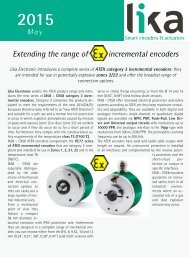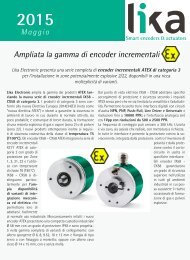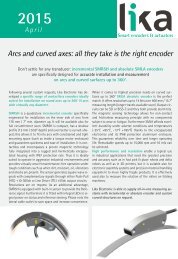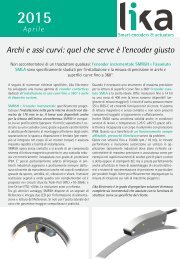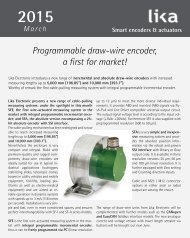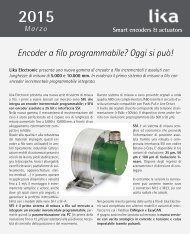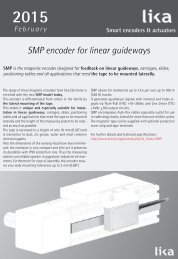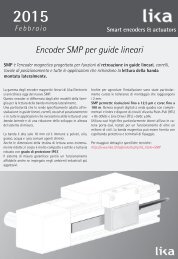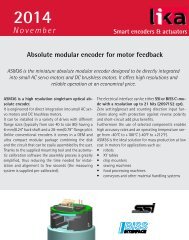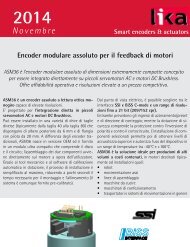LINEPULS & LINECOD catalogue 2016 in English
Lika Electronic incremental and absolute linear encoders catalogue 2016 in English Our new linear encoders catalogue is out now, and features many innovative new products and up-to-date information. The catalogue is expressly designed to set out the comprehensive range of incremental & absolute linear encoders from Lika Electronic. Check it out, it is completely renewed! Make sure you don’t miss out on a copy, download the pdf file from our web site or request your hard copy now! We have also got an interactive digital version in the works that shall be released soon!
Lika Electronic incremental and absolute linear encoders catalogue 2016 in English
Our new linear encoders catalogue is out now, and features many innovative new products and up-to-date information. The catalogue is expressly designed to set out the comprehensive range of incremental & absolute linear encoders from Lika Electronic. Check it out, it is completely renewed!
Make sure you don’t miss out on a copy, download the pdf file from our web site or request your hard copy now!
We have also got an interactive digital version in the works that shall be released soon!
You also want an ePaper? Increase the reach of your titles
YUMPU automatically turns print PDFs into web optimized ePapers that Google loves.
<strong>LINEPULS</strong><br />
Output signals<br />
Some <strong>in</strong>cremental l<strong>in</strong>ear encoders produce a Reference<br />
mark pulse (code R or code T) once per travel.<br />
It provides a datum position along the tape for use at<br />
power-up or follow<strong>in</strong>g a loss of power. An <strong>in</strong>tegral Reference<br />
sensor is designed to detect the external Reference<br />
magnet (order code LKM-1309/X where X is the pole pitch<br />
correspond<strong>in</strong>g to the one of the matched tape).<br />
The external Reference magnet is placed next to the tape at the preferred location to mark<br />
a relevant position <strong>in</strong> the travel (for <strong>in</strong>stance, the home position, otherwise referred to as<br />
calibration po<strong>in</strong>t). The amplitude of the Reference signal depends on the output circuit (see<br />
the Figure under the “Index pulse” po<strong>in</strong>t <strong>in</strong> the previous page): digital <strong>in</strong>cremental encoders<br />
provide a R code Reference signal, it has an amplitude of either 0V +5V or +10V +30V.<br />
S<strong>in</strong>e-cos<strong>in</strong>e <strong>in</strong>cremental encoders can provide either a R or a T code Reference signal (see<br />
the order code).<br />
R code Reference signal has an amplitude<br />
SME models<br />
accord<strong>in</strong>g to RS-422, while T code Reference<br />
signal has an amplitude of 1Vpp. Also<br />
the duration of the Reference signal varies<br />
depend<strong>in</strong>g on the output circuit: it is 90°<br />
±30° for Push-Pull and L<strong>in</strong>e Driver outputs;<br />
it is 70° ±10° for the s<strong>in</strong>e-cos<strong>in</strong>e output.<br />
As soon as the external magnet is detected<br />
an <strong>in</strong>tegral LED lights up. Please note that<br />
the LED switch<strong>in</strong>g on does not mean that<br />
the Reference pulse is output <strong>in</strong> the same<br />
time: the Reference pulse is usually synchronized<br />
with A and B channels with<strong>in</strong><br />
the South pole and has its own duration.<br />
Thus, it may be not output yet or be already<br />
output while the LED is lit. The Reference<br />
pulse can be provided with <strong>in</strong>verted signal.<br />
Reference mark pulse<br />
(R and T output signals)<br />
SMS models<br />
Please note that the Reference pulse is supplied as an alternative to the Index pulse: if<br />
the measur<strong>in</strong>g system is fitted with the Reference mark pulse, the Index pulse cannot be<br />
supplied.<br />
The series available with the external Reference mark pulse on demand are: SME11, SME12,<br />
SME21, SME22, SME51, SME52, SMS11, SMS12, SMS21.<br />
Some l<strong>in</strong>ear encoders <strong>in</strong>clude built-<strong>in</strong> limit switch sensors designed to detect two external<br />
limit switch magnets (order code LKM-1309/LS). The two sensors are activated by different<br />
external magnets, thus it is possible to dist<strong>in</strong>guish between the opposite ends <strong>in</strong> the travel.<br />
The external limit switch magnets have to be <strong>in</strong>stalled at the preferred location along the<br />
tape to mark the end limits of the travel. In this way at power-up or dur<strong>in</strong>g operation the<br />
controller can determ<strong>in</strong>e whether the encoder is at an end-of-travel and <strong>in</strong> which direction<br />
to drive the axis.<br />
The signals of the limit switches LS1 and LS2 are output through open collector type circuit<br />
and have Imax = 50 mA. The limit switch signal is normally at logic level HIGH (+Vdc) and<br />
switches to logic level LOW (0Vdc) as soon as the external magnet is detected.<br />
The signal is kept at logic level LOW (0Vdc) as long as the sensor is with<strong>in</strong> the active area of<br />
the external magnet. Integral LEDs light up as soon as the external magnets are detected.<br />
Limit switches<br />
The series available with external limit switches on demand are: SME12, SME22, SME52,<br />
SMS12.<br />
26




